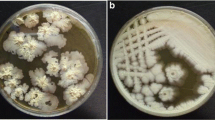Abstract
The interaction betweenBacteroides fragilis andEscherichia coli was investigated by following their growth kinetics in an in vitro mixed culture system. In Bacto-peptone or in a semisynthetic medium (SSM-M)Bacteroides fragilis could initiate growth only when a small number of viableEscherichia coli initially coexisted for a short period of time. Both Bacto-peptone and SSM-M previously spent byEscherichia coli also allowedBacteroides fragilis growth to occur but the supplementation of heat killedEscherichia coli cells or viable cell homogenates to fresh media failed to stimulateBacteroides fragilis growth. The in vitro stimulation ofBacteroides fragilis growth byEscherichia coli observed in this study may be best explained by the combination of (a) removal of oxygen and other toxic substances and (b) de novo production ofBacteroides fragilis growth stimulating factor(s) by coexistentEscherichia coli.
Similar content being viewed by others
References
DeHaan, R. M., Schellenberg, D., Pfeifer, R. T.: Bacterial etiology of some common anaerobic infections. In: Holloway, W. J. (ed.): Infectious disease reviews. Volume III. Futura, Mount Kisco, NY, 1974, p. 59–76.
Finegold, S. M., Rosenblatt, J. E.: Practical aspects of anaerobic sepsis. Medicine 1973, 52: 311–322.
Lorber, B., Swenson, R. M.: The bacteriology of intraabdominal infections. Surgical Clinics of North America 1975, 55: 1349–1354.
Altermeier, W. A.: The pathogenicity of the bacteria of appendicitis peritonitis. Surgery 1942, 11: 374–384.
Hill, G. B., Osterhout, S., Pratt, P. C.: Liver abscess production by non-spore-forming anaerbic bacteria in a mouse model. Infection and Immunity 1974, 9: 599–603.
Stone, H. H., Kolb, L. D., Geheber, C. E.: Incidence and significance of intraperitoneal anaerobic bacteria. Annals of Surgery 1975, 181: 705–715.
Onderdonk, A. B., Bartlett, J. G., Louis, T., Sullivan-Seigler, N., Gorbach, S. L.: Microbial synergy in experimental intraabdominal abscess. Infection and Immunity 1976, 13: 22–26.
Hagen, J. C., Wood, W.S., Hashimoto, T.: Experimental intraabdominal abscess formation byBacteroides fragilis andEscherichia coli. European Journal of Clinical Microbiology 1983, 2 (in press).
Kelly, M. J.: The quantitative and histological demonstration of pathogenic synergy betweenEscherichia coli andBacteroides fragilis in guinea pig wounds. Journal of Medical Microbiology 1978, 11: 513–523.
Kelly, M. J.: Wound infection: a controlled clinical and experimental demonstration of synergy between aerobic (Escherichia coli) and anaerobic (Bacteroides fragilis) bacteria. Annals of the Royal College of Surgeons of England 1980, 62: 52–59.
Nielsen, M. L., Asnaes, S., Justesen, T.: Susceptibility of the liver and biliary tract to anaerobic infection in extrahepatic biliary tract obstruction. 3. Possible synergistic effect between anaerobic and aerobic bacteria. An experimental study in rabbits. Scandanavian Journal of Gastroenterology 1976, 11: 263–272.
Rink, R. D., Kaelin, C. R., Raque, G., Trachtenberg, L. S., Fry, D. S.: Effects of pure or combined inocula ofEscherichia coli andBacteroides fragilis on the liver and related metabolism. Laboratory Investigation 1982, 46: 282–287.
Roberts, R. B., Cowie, D. B., Abelson, P. M., Bolton, E. T., Brilten, R. J.: Studies on biosynthesis inEscherichia coli. Publication No. 607. Carnegie Institute, Washington, DC, 1955.
Mayrand, D., McBride, B. C.: Ecological relationships of bacteria involved in a simple, mixed anaerobic infection. Infection and Immunity 1980, 27: 44–50.
Ueno, K., Sugihara, P. T., Bricknell, K. S., Attebery, H. R., Sutter, V. L., Finegold, S. M.: Comparison of characteristics of gram-negative anaerobic bacilli isolated from feces of individuals in Japan and the United States. In: Balows, A., DeHaan, R. M., Dowell, V. R., Guze, L. B. (eds.): Anaerobic bacteria: role in disease. Charles C. Thomas, Springfield, IL, 1974, p. 135–148.
Moore, W. E. C., Cato, E. P., Holdeman, L. V.: Anaerobic bacteria of the gastrointestinal flora and their occurrence in clinical infections. Journal of Infectious Diseases 1969, 119: 641–649.
Author information
Authors and Affiliations
Rights and permissions
About this article
Cite this article
Hagen, J.C., Wood, W.S. & Hashimoto, T. In vitro stimulation ofBacteroides fragilis growth byEscherichia coli . Eur. J, Clin. Microbiol. 1, 338–343 (1982). https://doi.org/10.1007/BF02019931
Issue Date:
DOI: https://doi.org/10.1007/BF02019931




